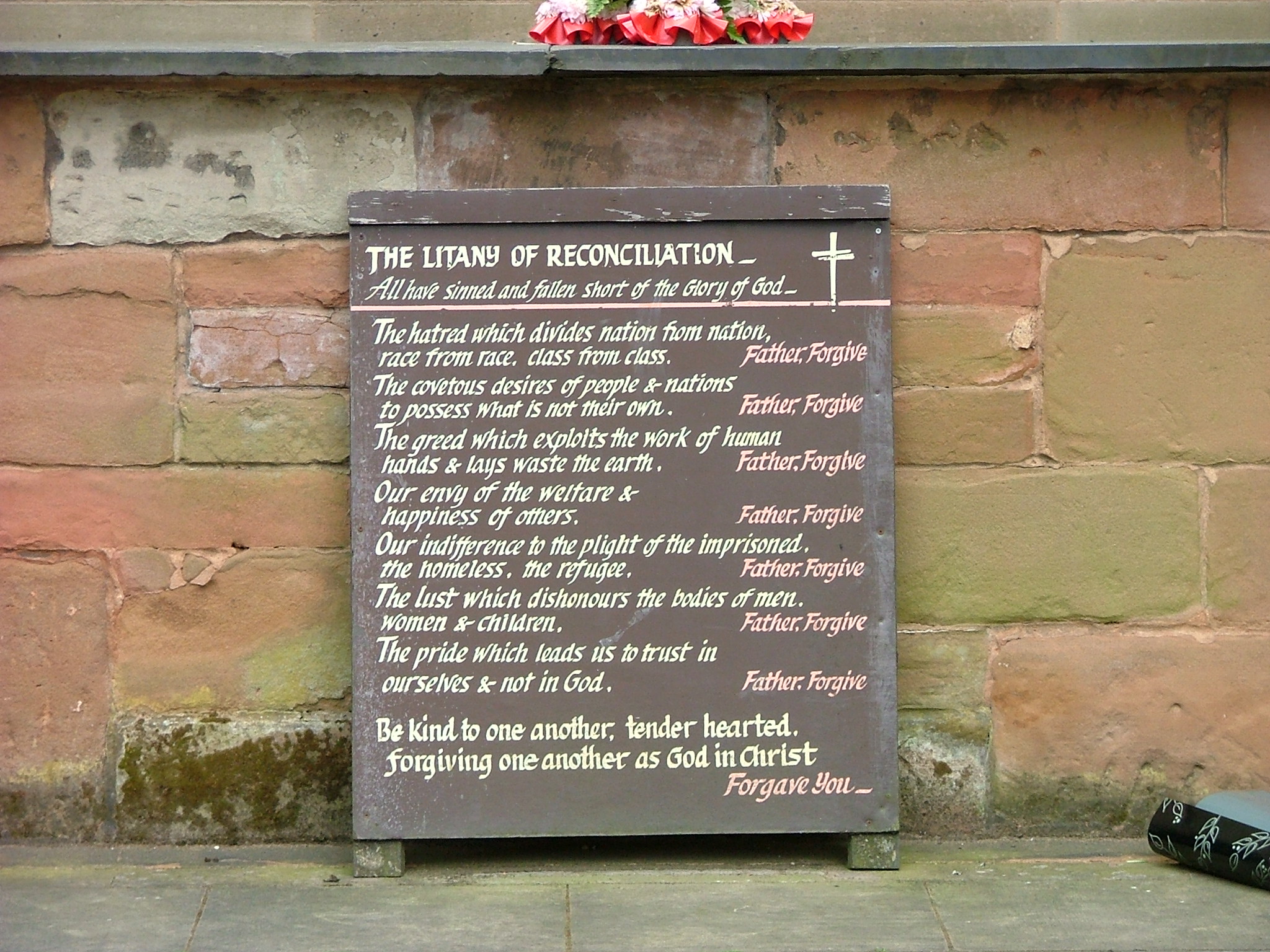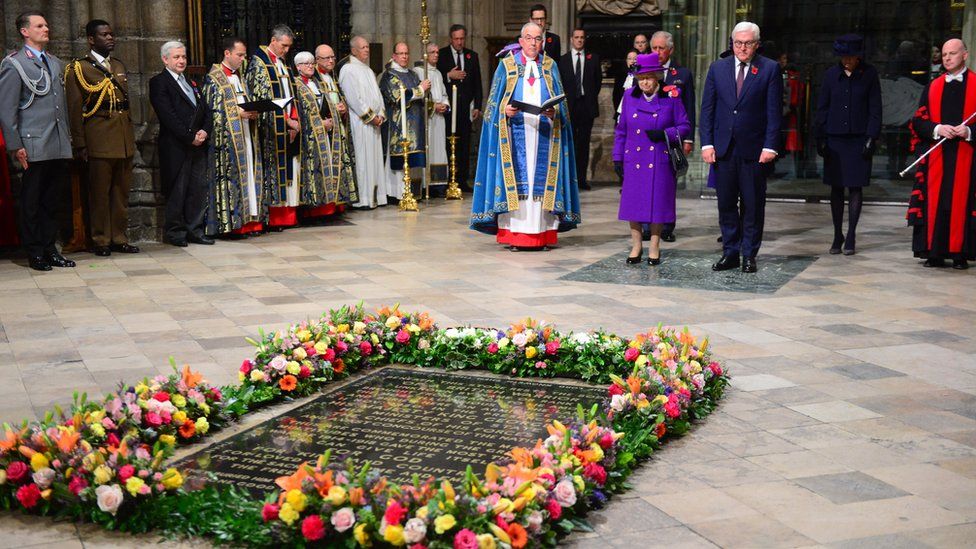- Details
- Written by: Kamran Mofid
- Hits: 1840
‘Are we forever doomed to be warriors, wired from birth to be belligerent? Or is there, deep inside our species, an equal propensity toward peace?’

The scene is the aftermath of a mustard gas attack on the Western Front in August 1918 as witnessed by the artist (John Singer Sargent)-Photo and Source
A century ago this week, the world’s first major industrialized war ended with an armistice. Across the globe, whole societies were forever changed by the war and the peace process that followed.
This week, is also the 78th Anniversary of the Coventry Blitz, my home city since 1974.
In recognition of these momentous anniversaries, and to encourage a further and more meaningful dialogue and understanding of the lasting imprint of these events on the present, I am recalling a sample of stories and articles that I have written over the past few years or so on war and peace, hatred and love, despair and hope.
But, first and foremost, I want to begin to pay homage to The man who changed the course of my life, when I first visited Coventry Cathedral in 1973 and saw these two words: ‘FATHER FORGIVE’:
The very Reverend Richard Thomas HOWARD (12 June 1884– 1 November 1981), Provost, Coventry Cathedral, 1933 to 1958
Reimagining a Better World: A World of Hope, Healing and Peace

Provost Richard Howard: The Man who Gave us the Gift of Forgiveness and Reconciliation
Provost Howard, whose vision and portrait of a humanity that need not be condemned to endless cycles of aggression was anticipated and foretold by a young British officer called Wilfred Owen, who died a mere week before the Armistice on November 11th 1918, one more senseless death among so many others senselessly wasted.
To quote Ariel Dorfman,* Owen was only 24 years old when he was killed, though he wrote some extraordinary poems about his wartime experience. In one of them, "Strange Meeting," he eerily anticipated the impending end of his own life, speaking of "the waste of war in its time." They are verses that today -- when humanity is assailed with similar stories of carnage, poisonous gas attacks and fears of apocalypse -- are just as painfully relevant as they were back then.
In that poem, Owen channels the voice of a soldier who strikes up an unnerving conversation with a dead man. Together, they mourn "the undone years, the hopelessness," until the dead man reveals he was killed the previous day by the very soldier narrating this encounter: "I am the enemy you killed, my friend... Let us sleep now."
Owen was to sleep forever, without seeing the conclusion of the "War to End All Wars," according to a phrase from H.G. Wells. As the interminable conflicts and victims of the next hundred years attest, nothing could have been further from the truth: we continue to slaughter each other as if the curse of Cain is ingrained in our DNA, as if we had learned nothing. Our political leaders attend war time ceremonies and keep promising to "protect the peace" while doing not nearly enough to really prevent war.
We live in a world ravaged by incessant strife and the rise of the extreme nationalism that led to the First World War, or the Coventry Blitz, for example, that so many now swear never to repeat.
‘Doctors in Syria and Yemen, mediators in Colombia and Afghanistan, citizens contesting rage in Israel and Palestine, peacekeepers in the Congo and Kosovo, women -- and men --denouncing war rapes, prove that there is no lack of brave members of our species ready to stand against the machines of war. What is lacking is the realization by us all that peace is a daily task, that must be carried out not by heroic, exceptional beings, but by every concerned parent and every vulnerable child.
Only when millions upon millions understand that struggle to be intimately theirs, will no more Wilfred Owens die, no more soldiers like him be sent to kill enemies whom they have never met and who could one day move in next door and become their best friends.’* Only then will all the brave and selfless peacemakers, like Provost Howard will rest, effectively, in peace.
*For the inspiration for the above piece, for the paraphrasing of the excerpts and more, I wish to thank Ariel Dorfman, for his excellent article, The boy who taught me about war and peace, which was originally published in the CNN on 15 November 2018.
...And now the stories, articles and more I had mentioned above:
Father Forgive: Its Impact on Me

Coventry and I: The story of a boy from Iran who became a man in Coventry
Centre for the Study of Forgiveness and Reconciliation
14 November 1940: The Destruction and Re-birth of Coventry
Coventry’s Message of Hope to the World on the Armistice centenary and Remembrance Sunday
A Non-Violent Path to Conflict Resolution and Peacebuilding- Kamran Mofid (Editor), et al
Istanbul Declaration: A Non-Violent Path to Conflict Resolution and Peacebuilding
Eurosceptics should visit Coventry Cathedral: The EU's Higher Purpose
Israel and Palestine: Can there be Peace?
The Road to Peace, Justice, Prosperity, Happiness and Well-being
- Details
- Written by: Kamran Mofid
- Hits: 3581
“...tomorrow morning Coventry will lie in smoke and ruins.” – Josef Goebbels, Ministry of Propaganda
At this time of nationalism and bombast, the Coventry message of hope reminds us of our shared humanity across backgrounds, faiths, civilisation and cultures. And at a time when our country is divided, pitting itself against our European neighbours, we’d do well to remember the hopeful and enduring story of Coventry.

St Michael's was elevated to cathedral status in 1918 but destroyed in 1940- Bridgeman Images

Photo:PA
The Enduring Beauty and Wisdom of Coventry Cathedral
This is Why Coventry Cathedral Has Inspired the World
After the devastation of World War Two, Coventry Cathedral, inspired by its visionary Provost, Richard Thomas HOWARD, did something remarkable – they sought forgiveness and reconciliation rather than revenge and more wars of destruction.

A Portrait Of Humanity: Provost Howard’s Gift to the World

The very Reverend Richard Thomas HOWARD (12 June 1884– 1 November 1981), Provost, Coventry Cathedral, 1933 to 1958
Richard Howard: The Man who has inspired us all to reimagine a better world: A World of Hope and Healing
This is Coventry’s Message to the World: Remember and Forgive, Reconcile and make Peace
A Message of Humility, Kindness and Hope
A Message for Our Time, A Message for All Time
14 November 1940: The Destruction and Rebirth of Coventry
“On 14 November 1940 the Luftwaffe launched its most devastating bombing raid of the Second World War so far. The target was Coventry, a manufacturing city in the heart of England with a beautiful medieval centre.”
‘in just one night more than 43,000 homes, 71 factories, the entire city centre, two hospitals, two churches and the police station had been destroyed by 449 German bombers, dropping 30,000 incendiary bombs. An estimated 568 people had died in the raid on the first night of bombing, with over one thousand people sustaining serious and life-threatening injuries;
‘as a result of their efforts, the Nazis coined the verb Coventrierung (literally, to Coventrate) to describe total annihilation of a city through aerial bombardment;
‘the next morning, while the rubble was still smouldering, Richard Howard, the cathedral Provost, had taken a piece of chalk and written on the sanctuary wall: “Father, Forgive”;
‘Richard Howard had made a bold move to break the cycle of vengeance. When the 1940 BBC Christmas Day service was broadcast from amongst the ruins of the cathedral, he vowed that, once the war was over, the cathedral would work with the people who had previously been their enemies “to build a kinder, more Christ-like world”;
‘inspired by the cathedral’s stonemason, who had made a wooden cross from the debris, Provost Howard made a cross from the nails that originally held the roof together. The destroyed altar was remade from the rubble, the crosses were placed on the new altar and the words “Father, Forgive” were inscribed on the wall behind;
‘after the war ended, the cathedral donated a “Cross of Nails” to the Kaiser Wilhelm Memorial Church in Berlin, which was also destroyed in the war. Today there are over 170 Cross of Nails Centres across the globe, each one owning a cross made from three nails from Coventry Cathedral, symbolizing the road to forgiveness and reconciliation…’ Continue to read: Father Forgive: It’s Impact on Me
The Coventry Litany of Reconciliation: The Charter for Forgiveness and Reconciliation the World Ever Needs

Photo: kmyra.ca
This is, once again, the timeless and noble message from Provost Richard Howard and Coventry Cathedral to those who think anger, revenge, retribution and war are what is needed to settle personal, regional and international disputes:
‘In the midst of war – a time when anger and defiance could have ruled the day – Provost Howard chose the harder, more transformative path. I wonder how our world might be changed today if we took on living the words of this Litany.’
‘After the bombing of Coventry Cathedral in 1940, Provost Richard Howard put the words “FATHER FORGIVE” on the wall behind the charred cross in the ruins of the destroyed cathedral in 1948. Not “Father forgive Them” – because we all have sinned and fallen short of the glory of God (Rom 3,23). These words have moved generations of people and are prayed in the Litany of Reconciliation every Friday at noon outside in the ruins, and in many other places around the world.
The Litany of Reconciliation, based on the seven cardinal sins, was written in 1958 by Canon Joseph Poole, the first Precentor of the new Cathedral. It is a universal and timeless confession of humanity’s failings, but it evokes us to approach these sins and weaknesses in the forgiveness of God’s love.’...Continue to read
...And this is What Provost Howard’s ‘FATHER FORGIVE’ has Meant for Today: Lest We Forget

The Queen and Germany's President Frank-Walter Steinmeier attending a remembrance service at Westminster Abbey for those killed and wounded in the First World War, on Sunday 11 November 2018, 100 years since Armistice Day. GETTY IMAGES
Thank you Provost Howard. Thank You.
- Details
- Written by: Kamran Mofid
- Hits: 1932

Photo:bing.com
'Corinthian, a behemoth of the for-profit college industry that marketed its vocational and post-secondary programs to single mothers at or below the poverty line...'
Last week I posted a Blog asking a pertinent question: What is EDUCATION if it is not about VALUES?
Today, after reading a fascinating article about the tragic and inhumane tale of profit-driven colleges in the US, scamming society’s most vulnerable (The new form of slavery), I came to appreciate even more the significance and the wisdom of the question I had asked above.
So, here you have it. Please first read What is EDUCATION if it is not about VALUES? If you have not done so already, and then, read the excellent review of the FAIL STATE by Jake Nevins, and begin to pity our world that has become so corrupt and values/moral/ humanity-free, destroying every fabric of our lives.
'Phenomenally saddening': inside the sordid world of America's for-profit colleges

Photo:documentary.org
The new documentary Fail State, tells the 50-year tale of profit-driven colleges scamming society’s most vulnerable in America
A Review by Jake Nevins*
In 2014, film-maker Alex Shebanow read about Corinthian Colleges, one of America’s largest for-profit college companies, while working on a documentary about student loan debt.
Relying heavily on federal student loans, from which it took $1.4bn in yearly revenue, Corinthian was on the brink of collapse after the department of education halted the company’s flow of federal funding due to evidence of rampant fraud in its reporting of grades and job placements.
Corinthian, a behemoth of the for-profit college industry that marketed its vocational and post-secondary programs to single mothers at or below the poverty line, was already under investigation by various federal agencies, the education department, and 20 different state attorneys general when it said it could not operate for more than a few days without an influx of cash. Internal documents revealed the for-profit specifically targeted “isolated” and “impatient” individuals with “low self-esteem”.
It was this run-in with the sordid underbelly of the predatory for-profit college industry – and a multi-state investigation into a company, QuinStreet, that set up an ostensibly government-run website funneling veterans to for-profits – that inspired Shebanow to expand the scope of his project. The result is his new documentary Fail State, an expansive and infuriating account of the rise of profit-driven colleges, their devastating effects on low-income students, and the ways Republicans and Democrats have aided and abetted their treachery.
“I don’t know how these people can sleep at night,” says Shebanow, whose work so impressed Dan Rather that the famed journalist signed on as an executive producer. “A lot of people don’t realize what’s percolating beneath the surface. It was crazy that no one had done a documentary on this until now and that it took a bunch of twentysomething film-makers to do it. I was always so worried someone was going to come out with a documentary of their own because the story is so big and important. I thought there was no way we were the only ones doing it. But somehow, that was the case.”
As Fail State explains in broad, digestible fashion, all of this began in 1972, when for-profits, often called proprietary, vocational, or career-driven colleges, became eligible for federal student aid under an amendment to Lyndon B Johnson’s Higher Education Act of 1965. The rerouting of financial aid money from institutions to students themselves was meant to allow private universities to compete with public ones, whose low costs made enrollment swell. But this opened the door for profit-driven colleges, who took advantage of the desire to make higher education more inclusive by encouraging students to take out huge sums of financial aid money.
These companies promised students eventual employment and, since the money was coming from taxpayers, had no vested interest in whether or not the students could pay back their loans. As an expert says in Fail State, for-profits had what amounted to risk-free access to the US treasury. Predictably, default rates soared in the 1980s, with almost half of all students at these colleges defaulting on their loans. By 1992, however, lawmakers began to wise up to the predatory recruitment practices and the virtually useless degrees these colleges were offering students.
At the time, a series of congressional hearings, and the attention of Congresswoman Maxine Waters (who appears in the documentary), helped set in motion a series of provisions that would allow for oversight of the for-profit industry: the 85-15 rule, requiring that at least 15% of the companies’ revenue came from sources other than government student aid; the 50/50 rule, ensuring no more than half of college courses were offered online or by mail; and the incentive compensation rule, banning college recruiters from receiving bonuses based on how many students they lured to the program. In the following decade, though, congressional interest in policing the for-profit sector waned and many of these regulations were dismantled or otherwise softened.
Shebanow’s documentary guides viewers through all this potentially wonky information with a careful hand, emphasizing the fact that Democrats and Republicans alike have been guilty of lenience toward and even support for profit-driven colleges. Sally Stroup, George W Bush’s assistant secretary for postsecondary education, was previously a lobbyist for the Apollo Education Group, which runs several for-profit institutions such as the University of Phoenix and Western International University. Nancy Pelosi and members of the Congressional Black Caucus, too, have also been historically cozy with representatives of the for-profit sector.
“It wasn’t like we set out to make the most non-partisan film that we could,” says the director. “It was more like, ‘Here are the facts’. And it was in some ways a happy accident that this issue transcends red and blue politics.”
Where Fail State makes its greatest impact is in the testimony it provides from students who were scammed. They attest to being harassed with phone calls, emotionally manipulated, deceived about costs, and persuaded that their post-secondary educations would land them implausibly high-paying jobs. A two-year investigation by the Senate health, education, labor and pensions committee, producing what Shebanow calls one of the most “damning” reports on a single industry in congressional history, found evidence of aggressive and insidious practices like the “pain funnel”, a script from which recruiters would read that was designed to prod at emotionally or financially susceptible prospective students.
A year into production, Shebanow and his team scoured the internet for these students and found hundreds of them commiserating in comments sections and company reviews.
“Part of what is so phenomenally saddening to me is that the people who are being affected and preyed upon by these schools are some of the most voiceless in our society, and their arcs are very similar,” says Shebanow, noting that students often encountered television, subway or internet advertisements for for-profits and received countless phone calls thereafter until they enrolled.
“They were promised the world. It was affordable. You don’t need to worry about your student loan debt. And they enrolled and realized their education was leading nowhere, or some realized the scam halfway through and dropped out, but had all this debt they’d taken on.”
That the president himself once ran a criminal for-profit education company – and that he’d appoint in education secretary Betsy DeVos a willing foot soldier for their cause – was not something Shebanow and his team anticipated when they began work on Fail State back in 2013. The saga of Trump University has been well-documented, but DeVos’s overtures toward the for-profit industry, including the elimination or rollback of Obama-era gainful employment and student borrower defense regulations, have gone mostly under the radar. DeVos, the director explains, is also tinkering with rules mandating “substantive teacher-student interaction”, which ensures students at for-profits are not navigating their coursework alone.
“As a journalist, you always dream of that hard-hitting story,” he says. “But the better the story, the worse the human tragedy. When I started this film I’d have never believed anyone who told me the film would be more relevant almost six years down the line.”
* This review by Jake Nevins was first published in the Guardian on Friday 9 November 2018
Lest We Forget
After giving us the 'BEST' University in the World
He then went on to become the 'BEST' Leader of the Very Free World!!

Yes, Trump University Was a Massive Scam
Trump University: It’s Worse Than You Think
And Now the Big Question:
What is the True Purpose of Education?
Values-led EDUCATION to Make the World GREAT Again
So away with the current values-free, for-profit education and usher in the new education model:
"Education to Build a Better Future for All"
Some say that my teaching is nonsense.
Others call it lofty but impractical.
But to those who have looked inside themselves,
this nonsense makes perfect sense.
And to those who put it into practice,
this loftiness has roots that go deep.
I have just three things to teach:
simplicity, patience, compassion.
These three are your greatest treasures.
Simple in actions and in thoughts,
you return to the source of being.
Patient with both friends and enemies,
you accord with the way things are.
Compassionate toward yourself,
you reconcile all beings in the world.-Lao Tzu
'We live in a world with many complex problems, at all levels, local, regional and global. It is said that education is the key that opens the door to a more harmonious world.
The pertinent question is: What kind of education and learning would help us address these challenges and create a sustainable world and a better life for all?
T.S. Eliot posed the question: "Where is the Life we have lost in living? Where is the wisdom we have lost in knowledge? Where is the knowledge we have lost in information?"
Reflecting on the questions above, we are going to need an education system that respects planetary boundaries, that recognises the dependence of human well-being on social relations and fairness, and that the ultimate goal is human well-being and ecological sustainability, not merely growth of material consumption.
The new education model recognises that the economy is embedded in a society and culture that are themselves embedded in an ecological life-support system, and that the economy can't grow forever on this finite planet.
In short, we need to listen to our hearts, re-learn what we think we know, and encourage our children to think and behave differently, to live more in synch with Nature.
If we do this successfully we can become wiser as a species, more “eco-logical.” We and the planet that gave birth to us can be happier and healthier, healed and transformed.'...
